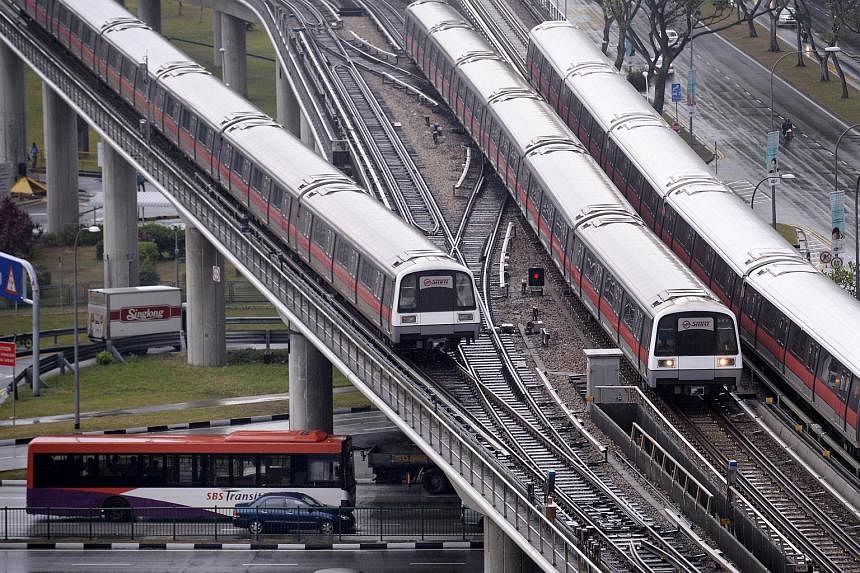The year will see several major plans move from the blueprint stage to the implementation stage.
First off, fares.
The annual public transport fare review now under way is expected to yield results - and revised fares - in the first quarter.
But already Transport Minister Lui Tuck Yew has said the rise this year - expected to take effect from April when approved - will be capped at 2.8 per cent.
Although this is smaller than last year's 3.2 per cent cap, the actual increase could work out to be similar to the two- to six-cent rise per ride fare revision last year. This is because of a larger ridership base, which also means the two operators could share a revenue increase of more than $50 million - the same as last year.
Operators justify their need for a fare adjustment with the usual cost increases (although fuel and energy costs have fallen substantially in the last year). But to commuters, there is - and always will be - only one justification: an improvement in service.
Buses
ON THAT front, the billion-dollar Bus Service Enhancement Programme seems to be addressing past shortfalls. Some 550 new state-funded buses have been put on the road since 2012, with another 450 due to join them by 2017. It is estimated that half of the 450 will start plying the roads this year.
Bus commuters can also look forward to another integrated transport hub (ITH) this year. The Joo Koon ITH - an air-conditioned complex that houses a train station and bus interchange - will be the eighth such facility.
Even so, there are still service gaps, illustrated by persistent complaints of overcrowding on services such as 77, 173, 190 and 972; and irregular arrival times.
The Government is addressing these issues. For example, a new central bus management system will facilitate real-time information flow between buses and bus stops and give commuters real-time information on bus arrival times. This will be rolled out progressively from this year.
At the industry level, a new bus contracting model is being adopted. The tender for the first package of routes closes on Jan 19. Under this model, operators bid against one another for the right to operate services, and the transport regulator keeps the fares. This insulates the operators from the risk of falling revenues, leaving them free to focus on meeting service standards.
Operators face penalties if they fail to meet standards but get rewards when they do.
Rail
RAIL commuters should begin to see some tangible improvement in service when limits on train speed on the North-South Line are completely lifted by March; and when more trains are injected into the entire network over the course of the year.
The power-supplying "third rail" on the North-South and East-West lines - the cause of two major breakdowns in 2011 - will be replaced progressively from the second quarter.
Work to build the new Canberra station in Yishun will begin this year. Upgrading works to make the Clementi, Commonwealth and Queenstown stations more accessible will be completed by the middle of the year.
Work will also start on an additional platform at Tanah Merah station. When completed in 2024, it will make rides between the Expo and Changi Airport faster.
But challenges still loom.
In the first three quarters of last year, there were 12 major rail disruptions (defined as delays of more than half an hour), more than the 11 incurred in the whole of 2011, which was possibly the worst year for train commuters.
Cross-border rail
MEANWHILE, cross-border rail projects with Malaysia may gain some traction this year, when Singapore completes its feasibility study on the high-speed rail link to Kuala Lumpur this quarter. It will address, among other issues, the site of the Singapore stop.
The MRT link to Johor Baru is still at a standstill, pending Malaysia's decision on where it wants to site its station. The decision on whether trains will go over or under the straits will follow.
Lastly, talks between SMRT and the Government on a new rail financing framework - which relieves the company of all operating assets - are expected to conclude some time this year.
On taxis, the first steps to simplify Singapore's convoluted taxi fare structure should be announced in the first quarter, but don't hold your breath for big-bang changes.
Regulations governing third-party taxi apps are also expected this year.
In the private transport sphere, consumers can look forward to a sizeable increase in the supply of Certificates of Entitlement (COE), which should lead to a drop in COE premiums, and thus to lower vehicle prices.
How much prices fall depends on whether the Government will start "saving" some COEs for the next low-supply period starting in 2021. This will undoubtedly be an unpopular move - especially with those who have been waiting for car prices to dip this year.
Those with cars will enjoy more roads to drive on. A new road between Yishun Avenue 1 and Yishun Avenue 6 will be completed this quarter. Four new flyovers linking the Central, Tampines and Seletar expressways with Seletar West Link will also be up by the end of the year.
Elsewhere, works to widen Clementi Road will start soon. And Bukit Timah Road should revert to its previous alignment this year, when Downtown Line 2 works near completion.
But the biggest road project scheduled to start this year may be delayed. Works on the 21km North-South Expressway, due for completion in 2020, may be pushed back to avert a labour and resources crunch.
Meanwhile, a billion-dollar project to build the next-generation electronic road-pricing system - one that can charge according to distance travelled - will be awarded this year. The system is expected to be up before 2020.
This story was first published in The Straits Times on Jan 8, 2015


